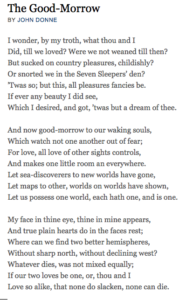WHEN A KID CATCHES A GLIMPSE OF HONEY, HE THROWS THE BEANS CAKE AWAY: MY REVIEW OF JOHN DONNE’S ” THE GOOD MORROW”

The Poem – John Donne’s “The Good Morrow” | Source: Octosection
The Good Morrow, an aubade written by John Donne is a metaphysical poem.
John Donne as a poet belongs to a sect of poets referred to as Metaphysical Poets. These poets regard poetry as more of a work birthed from artistic know-how rather than a synthesis or mixture of heart-inspired or emotional work.
READ ALSO: An Approach to Memoir; A Review of Abigail Thomas’s What Comes Next and How to Like It
This is so because most metaphysical poems are usually polished with a highly philosophical and academic touch. The rudiment of the knowledge of this category of poets is traceable to the branch of philosophy named “metaphysics”, a word formed by the editor of Aristotle’s works who was narrated to have got stuck and sort of words as to what name to give to the works of Aristotle after the ones on Physics which chronicled on topics outside the natural range of comprehension.
He then proceeded to name it “ta’ me ta phisika biblia,” meaning ” books after the books of Physics” which of course, in a more explicit sense connotes the philosophy beyond human comprehension or matters over that which no one can really give a final and univocal account of. George Hubert, Lord Alfred Tennyson, and others also belong to this category.

Major metaphysical poets | Source: Screencast (via YouTube)
You are reading: When a kid catches a glimpse of honey… review of John Donne’s “The Good Morrow”
The entire scenario that served as the creative impetus for the birth of Good Morrow was between the sixteenth and the seventeenth century, a period graced by the enthronement of Queen Elizabeth I. John Donne wrote the poem at a time when he started schooling at the Lincoln’s Inn where he engaged himself with learning History, Theology(the science of God or of religion), and Poetry.
During this period, there was political advancement, economic boom, and geographical extension in England as well as disasters. Some of the catastrophes that bedeviled England then included the England Civil War(1642-1651), the great plague(1665-1666), and the great fire of London(1666).
You are reading: When a kid catches a glimpse of honey… review of John Donne’s “The Good Morrow”
John Donne, while reflecting on the aforementioned pool of experience described the love between him and the object of his affection. John Donne described their previously individually spent moments apart as a period of innocence and complete loss, unconsciousness of self, and the environment which he categorically compared to the period in the life of a baby when he is not yet weaned but playfully feed on his mother’s breast which he cannot give an account of whether sweet if asked.
He didn’t stop at that, when adulthood catapults one into this lively moment of sexuality, one feels like questioning oneself that of what use has the past years been. He scribed that the gone years are akin to when the seven sleepers, as we have it in the historical myths, in order to avoid death judgement ostracized themselves out of the town to a cave and slept for almost 200 years. Imagine how boring, scary and tormenting that could be.
John Donne made it clear that having a glimpse of honey isn’t enough to make one throw the bean cake away, but having a real and practical taste of what it seems like does this better.
You are reading: When a kid catches a glimpse of honey… review of John Donne’s “The Good Morrow”
Love isn’t yet known to you if you merely are able to spell the four letters front-to-back and vice versa, but the actual knowledge of love is in being able to tell the advanced connotation of each letter of the world, the world of love. Portrait of every human being as imperfect when they’re individually assessed and judged is manifested in the poem as there is nowhere to find two individuals, who by the science of creation are two hemispheres, each entirely as a world of incomplete pleasures, everything halved, without sharp north, without declining west(imperfection) except when both merge to become one and perfect their flaws for each other.
In the end, John prescribes a solution to the problem of relationship failure by asserting that love not expressed in equal proportion between partners is the only one that stands the risk of dying.

